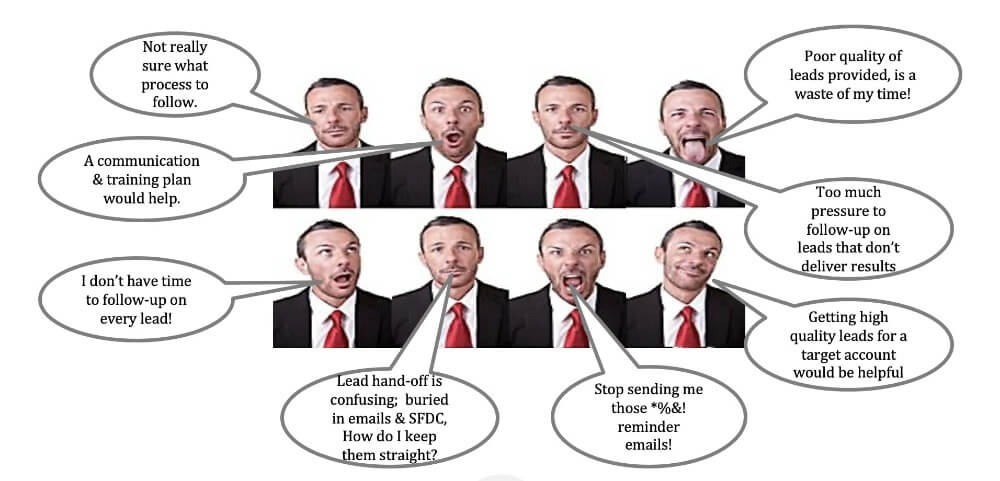It’s easy to shrug off this scenario as “the way it’s always been,” but misalignment between sales and marketing teams can create detrimental results and cost B2B companies 10% or more of their revenue per year. On the flip side, businesses with effective sales and marketing alignment achieve 27% faster three-year profit growth and close 38% more deals than organizations without alignment.
So how do you shift from working in disconnected silos to working as a collaborative, revenue-generating sales and marketing team? Read on to learn everything you need to know about creating powerful sales and marketing best practices.
- What Is Sales and Marketing Alignment?
- Initiating Sales and Marketing Best Practices Alignment
- What Problems Exist Without Sales and Marketing Alignment?
- Poor quality or inaccurate customer data
- Marketing campaigns don’t generate enough quality leads
- Marketing lead attribution models don’t hold water
- Under-utilized marketing content
- Clunky lead handoffs
- Marketing leads don’t get followed up by sales
- No visibility to lead follow-up performance
- The marketing budget and headcount get significantly reduced
- Bridging the Gap: Sales and Marketing Alignment Best Practices
- Marketing needs to take the initiative
- Strategize together from the start
- Establish a communications cadence
- Implement the 7 Customer Success Factors (CSF) of Demand Generation
- 1. Build a foundation of success with these guiding principles:
- 2. Speak the language of sales by getting to the core of their needs, which include real, quality opportunities, target accounts, and decision-makers.
- 3. Get down to the root causes of misalignment and poor lead follow-up.
- 4. Deliver quality leads from the accounts that sales care about.
- 5. Create high-quality, targeted sales enablement content and tools.
- 6. Proactively communicate, train, and provide ongoing support for your team.
- 7. Define and measure what success looks like. This includes putting in place common goals and staying consistent with the communications cadence both departments agree on.
- Work with clean data
- Track joint KPIs
- How Data Impacts Sales and Marketing Alignment
- Good Data Is the Gift that Keeps on Giving
- Learn more about Marketing and Sales Alignment
What Is Sales and Marketing Alignment?

Before we dive into sales and marketing alignment best practices, let’s start with what it is. Traditionally, sales and marketing teams have worked independently in their silos. In a broad sense, marketers focus on messaging, positioning, branding, demand generation, or lead generation. Sales teams focus on prospecting, building customer relationships, and closing deals to meet quota.
Sales and marketing teams have different functions and responsibilities, which makes it easy for them to operate on their own. But at the end of the day, both teams are critical in driving more revenue, and their efforts need to be coordinated like a well-oiled machine.
When sales and marketing alignment is in place, the results are higher-impact marketing activities, increased sales productivity, faster sales cycles, higher win rates, and rapid top-line revenue growth. Businesses are 67% better at closing deals when their sales and marketing teams are fully aligned.
Initiating Sales and Marketing Best Practices Alignment
So, how do you achieve sales and marketing alignment, and when do you know if you have reached that state? Over the past ten years, I have developed a proven collaborative approach across several companies—from start-ups to Fortune 500 companies—that span many industries on how to create sales and marketing alignment.
The most critical thing that needs to happen first is a paradigm shift within the mindset of the marketing leadership and team. Marketing must believe that the only way to survive and thrive is to take the initiative and focus on beginning the journey toward sales and marketing alignment.
Like everything else, sales and marketing alignment doesn’t happen on its own. Throughout my career as a demand generation marketing executive, implementing successful demand generation programs that deliver results, nine out of ten times, sales and marketing alignment began with marketing taking the lead, putting in place critical elements for alignment. In every company I’ve worked at, I’ve taken the lead and with the full support of my marketing team, have initiated the journey towards sales and marketing alignment.
Before we go into more detail on how to implement a collaborative approach toward sales and marketing alignment, let’s discuss the severity of what happens to organizations where sales and marketing alignment doesn’t exist.
The Role of Technology in Sales and Marketing Alignment
Leveraging the right technology is crucial to aligning sales and marketing teams. A shared tech stack can facilitate seamless communication, streamline workflows, and provide unified data insights. Tools like Customer Relationship Management (CRM) systems and Marketing Automation Platforms (MAPs) enable teams to track lead progression, measure campaign effectiveness, and analyze customer interactions in real time.
When both departments use integrated technology, it ensures that marketing campaigns are designed with sales insights and that sales teams can access up-to-date marketing materials and lead information effortlessly. Additionally, collaboration tools such as Slack, Microsoft Teams, or Trello can help maintain regular communication, track project milestones, and manage tasks, fostering a collaborative environment that bridges the gap between sales and marketing. By investing in the right technology, companies can enhance alignment, improve efficiency, and ultimately drive better business outcomes.
What Problems Exist Without Sales and Marketing Alignment?
When sales and marketing teams are not fully aligned, they often experience a lot of friction, inefficiencies, conflict, and lost revenue. And let me state something that may be considered unpopular but is true: Sales organizations will always hold the upper hand because they can directly prove ROI.
So without sales and marketing alignment, marketing organizations end up being discounted, forgotten, or—worse—dismissed from critical strategic conversations held at the executive table.
Below are several examples of problems that manifest because of a lack of sales and marketing alignment.
Poor quality or inaccurate customer data
If sales and marketing teams don’t create standardized processes for the technologies they use, a lot can get lost in translation. For example, it might be important for sales to see all lead notes in one particular area of a CRM, or it might be critical for marketing to have tags applied to certain customer subsets. If these two departments aren’t on the same page about standard processes, this could affect your organization’s data integrity, slow down workplace efficiencies, or in some worst-case scenarios, a loss of high-quality leads.
Marketing campaigns don’t generate enough quality leads
Some of the best and most effective messaging can come from salespeople who talk to prospects and customers every day. They are a great source of ideas and feedback for lead generation campaigns marketing teams plan to launch. They can also be a great sounding board to pressure test your messaging and content.
Without sales and marketing alignment, getting top salespeople to collaborate with and help launch effective marketing campaigns becomes quite difficult. Plus, without the alignment, the expectations from sales about the quantity and quality of leads can be a moving target—typically putting marketing teams on the defensive and behind the eight-ball.
Marketing lead attribution models don’t hold water
Marketing generally has a difficult time showing value-add because it’s hard to measure and prove how marketing contributed to the sales pipeline, which is a key contributor to the company’s overall revenue growth. Without a clear attribution model in place, marketing will have a hard time getting recognition—and getting credit for contributing to the pipeline is the ultimate lifeline for marketing organizations.
An attribution model needs to be created—not in a silo, but in collaboration with sales leadership and the finance team. What’s key here is that sales need to buy into how the attribution model works, and it needs to be simple and straightforward. If they are not on board, then all of the marketing efforts will be wasted.
Under-utilized marketing content
Marketing can create the greatest, most effective sales enablement content in the world—but without a clearly defined process on how to find and use it, sales teams can go on completely unaware that those content assets even exist. Without a process in place, sales teams experience roadblocks like being unable to find where content assets are stored or having the wrong or outdated version on hand. Reasons as simple as this often result in under-utilized content, and a lot of tension on both sides.
Clunky lead handoffs
Lead handoff is easily one of the top areas of friction most sales and marketing teams face. And similar to the challenge we touched on about under-utilized content, this issue goes back to having a clearly defined process and workflow. Nailing down logistics isn’t thrilling, but it’s critical to ensuring that everyone is on the same page and working together efficiently.
During my time at a healthcare company valued at $2.7B, many leads were buried in emails. And it was extremely time-consuming for salespeople to scroll through their inboxes to find a lead they had received. There was no easy way for salespeople to find the lead they were given. This ended up being one of the major reasons for the lack of follow-up, and creating a streamlined lead hand-off process was one of the easiest ways to fix the problem.
Marketing leads don’t get followed up by sales

In my experience, after implementing successful demand gen programs at over five companies, the lead follow-up by sales was abysmal—less than 20%. Imagine the conflict after marketing invested tens of thousands of dollars on launching a lead generation campaign, or thousands of resource hours creating and distributing content for a new product launch, and for only 20% or less of those marketing-generated leads to get followed up by sales.
The bottom-line answer is that many sales professionals have been burned in the past following up on marketing-generated leads that don’t meet the quality and information needed to convert these leads into closed deals. In many cases, many sales professionals have wasted precious selling time going down a rabbit hole, and as a result, seen a direct negative impact on their income levels.
If over half of your income was based on closing deals, could you afford to spend your time on leads that will never generate commission? If you did, would you make enough money to pay the mortgage, feed your family, etc.? The lack of perceived lead quality is quite serious, especially for sales professionals, who by design are driven and rewarded for focusing on deals that will close. This is why it’s so critical to get to the root causes and speak the language of sales—which we’ll take a closer look at later in the blog.
No visibility to lead follow-up performance

What gets measured, gets done. Lead follow-up is no exception. Here’s a good example of this challenge: At one of the companies I worked at, nobody was tracking the lead follow-up performance per salesperson. And that was to no fault of some of the sales executives. Given a technical glitch, some salespeople were never actually given leads but were expected by marketing to follow up on those leads they never received.
The marketing budget and headcount get significantly reduced
As we all know so well, companies don’t have unlimited budgets, and each department wants a bigger piece of the pie. Sales and marketing are two departments that are expected to generate revenue.
For sales, it’s very easy to show ROI, because almost every person in sales has a revenue quota to meet. They are paid to negotiate and close deals. When they close deals and meet or exceed their revenue quota, they have clearly demonstrated their ROI.
For marketing, it’s much harder to demonstrate ROI. Marketing mostly delivers activities and content that enable the sales process, but marketing doesn’t close deals. So, the conversation typically goes like this. Sales leadership will say, “A salesperson can deliver $1.5M of sales in one year, and each salesperson will cost us $150,000 per year, which is an ROI of 10. We need to grow the business by $15M, so I need to hire 10 sales professionals.”
It is a very logical and strong argument: Let me hire 10 salespeople, and I will deliver $15M for a cost of $1.5M. Marketing, on the other hand, says I need $1.5M to deliver 50 webinars, generate 50 blogs, deliver 2 events, and so on. But where is the payback?
Marketing’s value is not from just staying busy and performing activities, marketing’s ultimate value comes from generating a pipeline. This is a strong example of why sales and marketing often compete for resources. If there is a lack of sales and marketing alignment, 99% of the time, marketing will not be able to demonstrate value, justify the budget ask, and will lose to sales when it comes to budget allocation.
On the other hand, collaborative, aligned teams understand the value everyone brings to the table, and they’ll work with one another to generate the most revenue possible for the organization. At a startup company where I headed the entire marketing department, sales leadership saw the value, and they argued on my behalf to increase my budget! Why? They knew if the company invested more in marketing, the pipeline would grow significantly, and they would increase their chances of exceeding their quota.
With sales and marketing alignment in place, sales depended on marketing for their success. And in turn, sales worked hard to make sure that my marketing organization had all the necessary resources, tools, and budget to continue to deliver more qualified opportunities.

Bridging the Gap: Sales and Marketing Alignment Best Practices
As you can see, misalignment decreases team productivity while increasing hostility. More importantly, most marketing leaders and team members don’t survive budget cutbacks and/or organizational reengineering (a fancy way of saying layoffs) when sales is not happy with marketing.
I have countless examples of my peers—CMOs, VPs, or Directors of Marketing—who were fired because they didn’t meet or exceed the expectations of sales leadership. If sales is not happy, the marketing leader’s days are numbered—plain and simple.
Well-aligned sales and marketing teams can overcome this challenge, along with all the other challenges we’ve outlined above. Here, you’ll find our top sales and marketing alignment best practices to help cultivate a healthy relationship between your sales and marketing teams.
Marketing needs to take the initiative
As we mentioned earlier, it’s imperative for marketing to take the initiative. This means speaking the same language that sales do and determining how much pipeline marketing needs to generate to help the company succeed. Approach the conversation by understanding what sales need to be successful from a pipeline enablement and lead generation perspective, and remember that marketing is there to serve sales. In a way, sales is like marketing’s most important customer.
Strategize together from the start
Most teams are naturally inclined to develop strategies independently, reviewing and refining them within their internal department until it’s polished and ready to share with everyone else. The problem with this is that a team can pour hours into a strategy only to realize they are missing important insights, or that their plan clashes with the other department’s plan. If you want sales and marketing to become aligned, you’ll have to break away from this and strategize with each other from the start.
Establish a communications cadence
When you begin to execute your goals, you need a standardized process for working together. This includes using agreed-upon terminology to eliminate confusion, and determining how often you expect sales and marketing team members to interact. Will there be check-ins and reviews for specific milestones? Are you reviewing dashboards and progress on a bi-weekly or monthly schedule? What systems and platforms will you both use? Establishing a clearly defined cadence will streamline collaboration going forward.
Implement the 7 Customer Success Factors (CSF) of Demand Generation
Over the past 10 years, I’ve discovered and implemented seven critical success factors (CSF). These 7 CSFs guaranteed success every time I needed to roll out a demand-generation engine that relied heavily on sales and marketing alignment.
1. Build a foundation of success with these guiding principles:
- Focus on quality, not quantity.
- Eliminate any work that doesn’t add value—keeping it simple streamlines operations and saves everyone time.
- Drive transparency across departments.
- Implement a holistic and integrated approach to sales.
- Communicate frequently and embrace continuous improvement.
2. Speak the language of sales by getting to the core of their needs, which include real, quality opportunities, target accounts, and decision-makers.
3. Get down to the root causes of misalignment and poor lead follow-up.
4. Deliver quality leads from the accounts that sales care about.
5. Create high-quality, targeted sales enablement content and tools.
6. Proactively communicate, train, and provide ongoing support for your team.
7. Define and measure what success looks like. This includes putting in place common goals and staying consistent with the communications cadence both departments agree on.
Rolling out the seven CSFs has been instrumental in improving performance and alignment at every company I’ve led marketing at. To learn more about why these success factors are so important and find actionable tips for implementing them, make sure to read this article where we take a deeper look.
Work with clean data
It sounds so simple, but working with clean data is a critical best practice that often goes overlooked. The accuracy and completeness of your B2B contact data impact both sales and marketing in substantial ways.
For sales, incorrect phone numbers or email addresses mean hours wasted trying to track down accurate contact information to get in touch with prospects. And when a B2B contact has minimal data, rather than a complete profile with important data attributes like job title, industry, location, and more, sales teams are not as well-equipped to sell.
For marketing teams, inaccurate data means that campaigns they’ve worked hard on may not even reach the right or relevant people. Bad email addresses could also contribute to a high email bounce rate, potentially flagging your organization’s domain as spam.
When you’re dealing with bad data, it’s easy to point fingers at one another. In truth, data hygiene is a laborious process that shouldn’t be pushed on sales or marketing team members to handle. Instead, third-party data platforms can provide verification on demand for all of the contacts in your CRM, and even enrich all of your B2B contacts with additional fields that are important to you, like company size, job title, social media profiles, and more.
Track joint KPIs
One of the key challenges in aligning sales and marketing teams is that they are often measured differently, which can lead to conflicting priorities and goals.
By establishing joint key performance indicators (KPIs), companies can help to ensure that sales and marketing teams are aligned around a common goal and working together to drive business success.
Joint KPIs that sales and marketing teams could track together include:
- Sales revenue generated from marketing leads: This KPI measures the amount of revenue generated from leads that originated from marketing efforts, helping to demonstrate the impact of marketing on overall sales performance.
- Lead-to-sale conversion rate: This KPI measures the percentage of leads that ultimately convert into paying customers, and can help to identify areas where sales and marketing alignment may be lacking.
- Customer acquisition cost (CAC): This KPI measures the cost of acquiring a new customer, and can help to identify areas where sales and marketing efforts may be inefficient or ineffective.
By tracking these joint KPIs, sales and marketing teams can better understand how their efforts are contributing to overall business success, and work together to optimize and improve performance.
Regular meetings between sales and marketing teams can also help to foster collaboration and ensure that both teams are aligned around shared goals and metrics. Ultimately, by working together and focusing on shared KPIs, companies can drive greater revenue growth and business success.
How Data Impacts Sales and Marketing Alignment
Working with fresh, accurate, and complete data is one of the best-kept secrets of high-performing, aligned sales and marketing teams. Many organizations focus on the collaborative aspects to achieve sales and marketing alignment—like frequent meetings, sharing goals, and communicating regularly—but don’t pour as much into the tangible items that impact workflow, productivity, and daily tasks.
Cleaning up and updating your B2B contact data doesn’t have to be a stressful, labor-intensive endeavor. Third-party data platforms can automate that work for you. At DealSignal, we provide data verification and enrichment on-demand with an industry-leading accuracy rate of 97%+. Below are just a few examples of how DealSignal’s data platform can help improve sales and marketing alignment.
Eliminating bad leads
Often, sales can’t see the value in the leads that marketing generates because they’re not immediately actionable. When leads are missing key contact details, such as direct-dial phones, or the data provided is incorrect, salespeople end up wasting time on manual research or reaching out to people who aren’t qualified. And if there’s one thing good salespeople hate, it’s wasting time.
Sarah Strid, Senior Manager of Demand Generation at FloQast, understands these issues all too well. As noted in a case study, FloQast was generating a high volume of leads through numerous marketing programs, such as events, webinars, and third-party partnerships. But unfortunately, a lot of contact and account data being generated was incomplete and inaccurate.
“If there’s ever a bad list or contact data is inaccurate it bounces—that’s huge from a systems and programmatic aspect—but it’s also really detrimental to the relationship between our sales and marketing teams because they’re not going trust that what marketing is providing to them is really high value,” says Sarah.
“Pre-event lists and leads collected at conferences were always a challenge because the data is often incomplete or incorrect, resulting in a lot of time wasted trying to manually enrich data instead of reaching out to prospects or following up on leads.”
She continued: “We’re running several campaigns and if we’re generating X amount of contacts and none of them are accurate, it doesn’t matter at all. Marketing isn’t driving value to sales or to the company as a whole.”
FloQast was able to overcome its “bad lead” issue with on-demand lead enrichment. They’ve re-verified and updated their CRM data and enriched contact data to drive better results for their campaigns and provide more value to the sales team.
“With complete, accurate data, we’ve been able to do more pre-event outreach, such as booking demos prior to a conference—something that we historically had greater difficulty doing. We’ve also been able to run more targeted programs,” says Sarah.
Creating stronger target personas
Teams that create target personas together, stay together.
Another way to create sales and marketing alignment is to have your teams work hand-in-hand to develop detailed target personas, as well as ideal customer profiles (ICP) and lead qualification criteria. This prevents future misunderstandings and you can work together more effectively to target your total audience and drive conversions.
With agreement on your target personas and ICP, you can measure your total audience (TAM), evaluate the coverage in your CRM and marketing automation platform, and perform contact discovery to fill any gaps with complete, accurate data. We’ve performed thousands of TAM analyses and people are always surprised to see how many target contacts they’re missing—we find the average TAM coverage is only 17%!
More effective ABM
Jeremy Middleton, Senior Director of Rev Operations & Digital Marketing at Pramata knows about getting Marketing and Sales aligned to reach their total audience.
As detailed in this ABM case study, Pramata wanted to complement their inbound and events programs with an ABM and account-based sales approach but lacked complete and accurate data for the contacts in their target accounts, so they were wasting a lot of active selling time on research and dead ends.
Jeremy worked with the business development reps to align their teams and re-focus on their very largest target accounts, to further refine their target personas, and to enrich their CRM data, increasing TAM coverage from just 30% to 99%. The teams also worked together to create detailed account engagement plans with personalized content and customized messaging.
“Now that we’re enriching our SFDC deployment with fresh accurate data, we can confidently take a highly-personalized approach to ABM—and it’s having a positive impact at every level. Our email open rates have doubled, click rates have quadrupled, and we see a 4x lift in sales conversions,” says Jeremy.
“Our Sales team is more efficient—we have significantly reduced time spent searching for direct phone numbers and spend less time chasing untargeted prospects. We now have valuable ammunition to personalize our outreach to our target market and personas to engage them more effectively. This has enabled us to move deals through the pipeline with a greater velocity and increase our conversion rates,” he continued.
Good Data Is the Gift that Keeps on Giving
Along with implementing sales and marketing alignment best practices, working with fresh, accurate, and complete data for all the contacts in your target accounts is key. Data is the fuel to your revenue engine—just look at Sarah, Jeremy, and hundreds of other high-growth companies that improved team performance with DealSignal.
To learn more about how DealSignal’s data platform can help your sales and marketing teams reach their goals, request a free demo here.

Live B2B Data Solutions. Clear and Transparent Pricing. Exceptional Customer Assistance. Depend on DealSignal.
Learn more about Marketing and Sales Alignment
- A Guide to B2B Data Platforms Providers
- Best Lead Enrichment Tool for 2024
- B2B Marketing Trends to Master in 2024
- DealSignal vs. ZoomInfo: Comparison Guide
- Marketing Play: 5 Strategies to Execute Before the Clock Runs Out
- How Data Accuracy Impacts Sales and Marketing Performance and Costs
- Demand Generation vs. Lead Generation: Key Differences and Strategies
- B2B Email Marketing: Best Practices and Essential Tips for 2024




